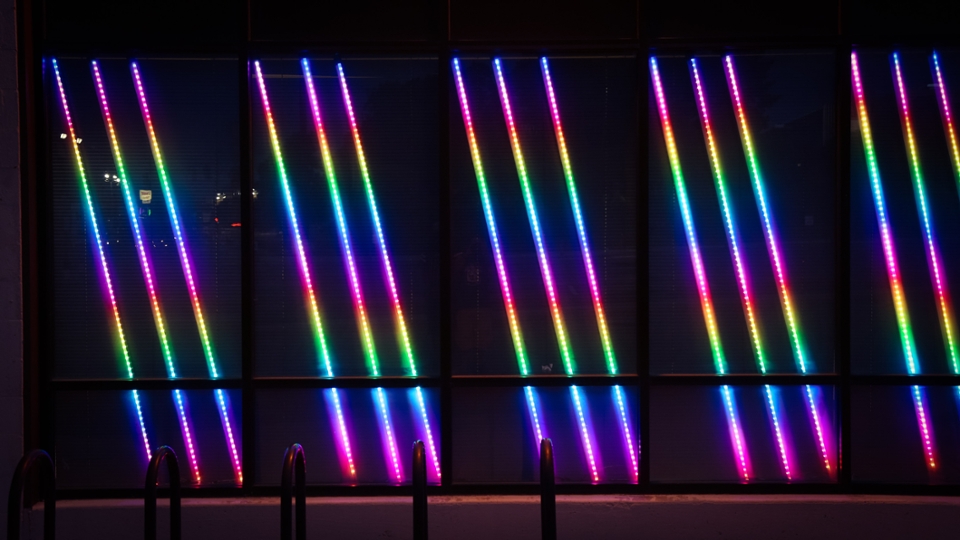STEAM project on CARC lights up the night on Route 66
 The iconic Route 66, also known locally as Central Avenue, is famous for the neon lights that have been luring tourists and locals alike to diners, motels, and shops along the Mother Road for more than 50 years. The University of New Mexico Social Media Workgroup and the UNM Center for Advanced Research Computing are keeping the history of eye-catching light displays on the historic strip alive with a contemporary, more sustainable twist.
The iconic Route 66, also known locally as Central Avenue, is famous for the neon lights that have been luring tourists and locals alike to diners, motels, and shops along the Mother Road for more than 50 years. The University of New Mexico Social Media Workgroup and the UNM Center for Advanced Research Computing are keeping the history of eye-catching light displays on the historic strip alive with a contemporary, more sustainable twist.
Pass by the Center just west of the corner of University and Central any evening and you’ll see a series of lights changing color and zigzagging through the windows on the south and east side of the building. The lights are LEDs, not neon. And they’re not just pretty colors. The project is called Data Central: A Public LED Platform for Near Real-time Driven Animation, led by Professor Andrea Polli, Ph.D., UNM professor of Art and Ecology. Bringing together a team with diverse skill sets, including undergraduate student researchers in engineering Brandon Wade and David DiDonato, and STEAM New Mexico AmeriCorps VISTA specialist Madeline Bolding, Ph.D., the SMW developed an attention-grabbing work of technology and public art.
Bolding explained how data gathered from donated brain regions is expressed in Data Central through colored lights. Currently the movement and colors are tied to data coming from the study of genetic material by BrainSpan consortium from people who donated their brains after death for scientific research, she said.
Every cell in the body contains the same genetic material. But while every cell contains the same genes, not all genes are “turned on” or “expressed” all the time or at the same rate, Bolding explained. The genes are “expressed” in different combinations and at different times, making the difference between, say, a kidney and skin cells.
The LEDs in CARC’s windows reflect those various expressions of genes in parts of the brain. Different colors show the level of expression in units called Reads Per Kilobase Million or RPKM. Colors range from white at 300-500 RPKMs to red at 901-1,400 RPKMs.
A few of the genes chosen to be represented for the display are:
ESPN – This gene helps to transform a mechanical signal into one the brain can understand. Mutations can cause deafness.
DEAF1 – This gene is important in embryonic development and mutations can result in mental retardation.
CASP9 – Caspases are the Grim Reapers of the cell world. These genes tell a gene when its job is done or something is wrong and it should kill itself. CASP9 triggers if a cell experiences DNA damage from sources like UV light or radiation. Since DNA damage can lead to cells dividing too quickly, CASP9 helps kill the cell before it becomes cancerous.
BRAT1 – This gene is associated with suppressing breast cancer.
The genetic data is not the first to be channeled through the display. In the past, weather and traffic data were also echoed in the streams of lights.
While LEDs resemble Route 66’s famous neon displays, the LEDs are more energy efficient, requiring only a fraction of the electricity required to power neon. Also, the LEDs outperform the neon, with computer controlled patterns, brightness, speed, and colors.
When passersby see colored lights snaking across the CARC façade, they are also seeing a representation of the innermost workings of the brain on a genetic level.
The Data Central team, led by Polli, has also included Jazmyn Crosby, Frank Feng, Gabrielle Herbosa, Trent Small, Isaiah Smith, Jared Rendon-Trompak, Matthew Barbato, Britney King, and Eric Geusz.
Polli has directed other light and data projects, including the Skylight project at the Albuquerque Balloon Park, and the Energy Flow project on the Rachel Carson Bridge in Pittsburgh, PA.
See more about the Data Central project and others on the SMW website.
